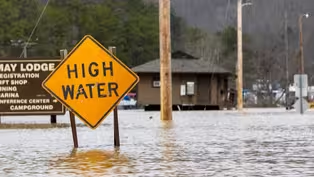
Harmful Algal Blooms Found at Kentucky Lake
Clip: Season 3 Episode 282 | 6m 52sVideo has Closed Captions
State officials are warning people about what to do if you come in contact with one of these blooms.
Two harmful algal blooms at Herrington Lake remain at unsafe levels. State officials are warning people to stay out of the lake near Paradise Camp and Tanyard Branch, also called Redgate. Christie Dutton spoke with a state expert about algal blooms to learn what they look like and what you should do if you come into contact with one.
Problems playing video? | Closed Captioning Feedback
Problems playing video? | Closed Captioning Feedback
Kentucky Edition is a local public television program presented by KET

Harmful Algal Blooms Found at Kentucky Lake
Clip: Season 3 Episode 282 | 6m 52sVideo has Closed Captions
Two harmful algal blooms at Herrington Lake remain at unsafe levels. State officials are warning people to stay out of the lake near Paradise Camp and Tanyard Branch, also called Redgate. Christie Dutton spoke with a state expert about algal blooms to learn what they look like and what you should do if you come into contact with one.
Problems playing video? | Closed Captioning Feedback
How to Watch Kentucky Edition
Kentucky Edition is available to stream on pbs.org and the free PBS App, available on iPhone, Apple TV, Android TV, Android smartphones, Amazon Fire TV, Amazon Fire Tablet, Roku, Samsung Smart TV, and Vizio.
Providing Support for PBS.org
Learn Moreabout PBS online sponsorshipTwo harmful algal blooms at Harrington Lake remain at unsafe levels.
State officials are warning people to stay out of the lake near Paradise Camp, and tenured branch, also called Red gate.
I spoke with a state expert about harmful algal blooms, what they look like, and what to do if you come in contact with one.
You may have heard more about harmful algal blooms in Kentucky's news lately, and if you're not really sure what that is, you're not alone.
Here to answer some questions about it is environmental scientist Melanie Arnold with the Kentucky Division of Water.
That's part of the Energy and Environment cabinet.
So Melanie, tell us what is a harmful algal bloom?
So a cyanobacteria are naturally occurring in our waterways.
However, when we get certain conditions like sunny warmer weather, maybe some higher nutrient levels in the waters and lower flows, the cyanobacteria tend to grow rapidly at times and can produce these blooms that we're seeing.
And sometimes these blooms produce toxins as well.
And that's what we're particularly concerned about with public health.
Okay.
Well how what exactly do they look like?
How would we recognize them?
Often the the blooms that we see in our area are a bright green, bright green color.
They can look like maybe spilled paint or some people say pea soup.
You may see green streaks in the water.
And if you look more closely you may see a grainy or sawdust like, texture to them.
They can also be other colors like blue, green or red or brown in our areas.
And we do have some pictures up on our website.
If people want to check out our our web page to see some examples.
Okay, so how are they harmful to us then?
What sort of symptoms might we experience?
Sure.
Yeah.
It's the cyano toxins that we're particularly concerned about such as microcystin and when people are exposed, they can experience a variety of symptoms, potentially, depending upon their level of exposure and the concentrations that they experience.
And, the length of time that they're exposed and any underlying health conditions evolve.
But some of the symptoms could be, skin, eye or throat irritation.
Some people may had some difficulty breathing.
There can also be symptoms such as stomach pain, nausea, vomiting or diarrhea.
And in some of the most severe cases, there's potential for liver damage as well.
Okay, so, these two harmful blooms without the two harmful blooms that have been detected in Harrington Lake.
So, are people not allowed in that area or are they advised not to?
What sort of restrictions?
What should people be doing or not doing in that area?
So as the division of water, we don't prevent people from recreating in that part of the waterway.
We just want to provide appropriate information for people to be able to make the decisions that's best for them.
So our recommendations currently for areas above our recommended, recreational advisory level, we would suggest that people avoid, activities such as swimming, wading, paddling, you know, activities that create, a spray like jet skiing or water skiing in those affected areas.
And also, you know, if people see areas where there are indicators of the bloom that we discussed earlier, those would be areas we'd recommend that people try to stay out of it if possible.
And if people think they've been exposed, we recommend that they, you know, rinse off with clean water.
If they have symptoms, contact their doctor or the local health department for additional information.
What about fishing in that area?
Is it okay, to eat the fish and, and then also drinking water that may come from some of these, waterways?
Sure.
So our recommendations currently for fishing would be that, you know, you fillet the fish, rinse the fish with clean water and don't consume any of the organs.
And, you know, if you are fishing in an area, just be conscious of, you know, the bloom that that you may be around.
So if there are other areas outside the bloom, that would be potentially your better option.
And in terms of drinking water, we work closely with the the Danville Water Treatment Plant.
And we had staff on site this week.
They're not seeing any issues with treating the drinking water.
The the water company or the water plant is familiar with these sorts of conditions and has the treatment, to address these sort of seasonal, conditions that we're seeing.
So as of right now, they're not reporting having any issues.
And we haven't, seeing the bloom in that area, from what's been reported so far.
What kind of waterways would we be most likely to find these harmful algal blooms?
Well, cyanobacteria are present in our waterways.
We do tend to see blooms on smaller bodies of water, you know, areas where, there's a lot of nutrients that can easily get into that water and feed a bloom.
But it is possible to see them in other areas, you know, any area that's also maybe slow moving doesn't have a lot of movement to the water, content to form a bloom more easily.
Okay.
What other bodies of water in the past have these been spotted on besides Harrington Harrington Lake, which is currently happening?
You know, we've had, a few different advisories throughout the years.
We've been monitoring since approximately, 2013, I believe, you know, I know the the blooms on the Ohio River tend to make the news on occasion.
So we've seen them there.
There's been a few years where we have had a bloom reported on Harrington Lake.
We haven't issued any advisory in the past, but, some of our smaller lakes, fish and wildlife lakes across the state, we tend to see them.
Is this something that we expect to see more of with temperatures really, warming up this summer?
You know, we are early in the season, so there is the potential to see additional blooms this year.
You know, anytime we get, like, long dry periods or these hotter, sunnier, weather, then, you know, we do have the potential to form blooms.
Unfortunately, predicting the blooms is, is still challenging.
And a lot of people are doing research on how to better dial in the tools to be able to predict when and where blooms may occur.
If you think you've spotted a harmful algal bloom, you can report it to the division of water by calling 5026 I'm sorry.
5643410.
Again, that's (502) 564-3410 or emailing water at keycap.
After hours and on weekends, contact the 24 hour hotline at 1-800-928-2380.
Kentucky's A.I. Task Force Reconvenes in Frankfort
Video has Closed Captions
Clip: S3 Ep282 | 4m 1s | The legislative task force held its first meeting of the 2025 interim period on Thursday. (4m 1s)
Nate Morris to Run for U.S. Senate in Kentucky's GOP Primary
Video has Closed Captions
Clip: S3 Ep282 | 2m 10s | The Lexington businessman joins two other Republicans hoping to succeed Sen. McConnell. (2m 10s)
New Task Force Focused on Disaster Prevention
Video has Closed Captions
Clip: S3 Ep282 | 3m 2s | The newly created task force held its first meeting on Friday. (3m 2s)
Providing Support for PBS.org
Learn Moreabout PBS online sponsorship
- News and Public Affairs

Top journalists deliver compelling original analysis of the hour's headlines.

- News and Public Affairs

FRONTLINE is investigative journalism that questions, explains and changes our world.












Support for PBS provided by:
Kentucky Edition is a local public television program presented by KET


